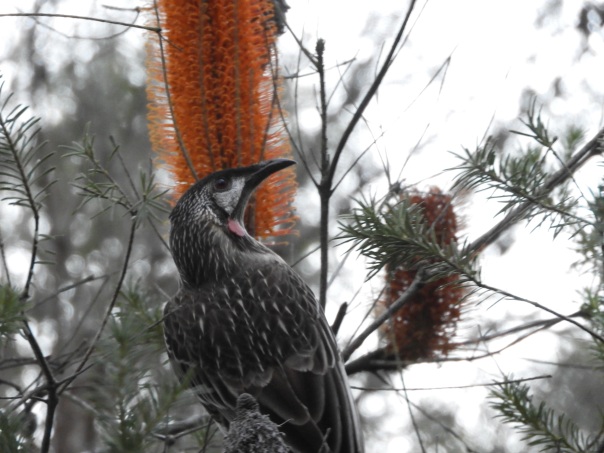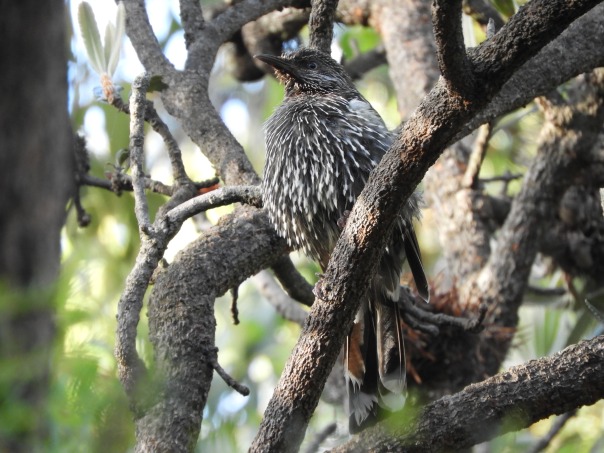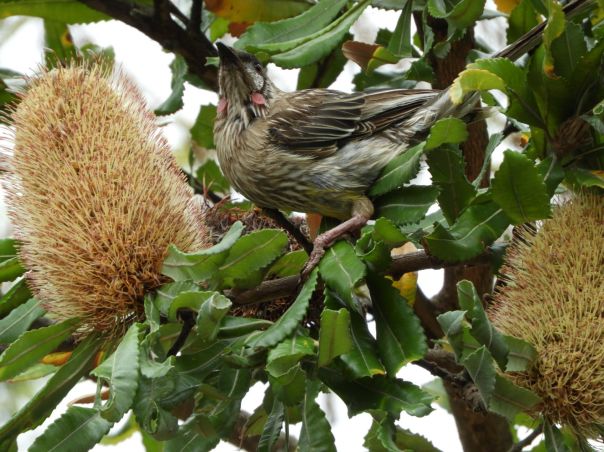Blog Archives
Call of the Red Wattlebird
This Red Wattlebird was quite chatty in the crisp morning air.
Usually when walking in the bush I hear the more raucous croaks of this bird and its cousin, the Little Wattlebird. So it was nice to hear something a little more melodious.
Here’s a still picture of the Red Wattlebird, showing the red flap below its eye which gives the bird its name:
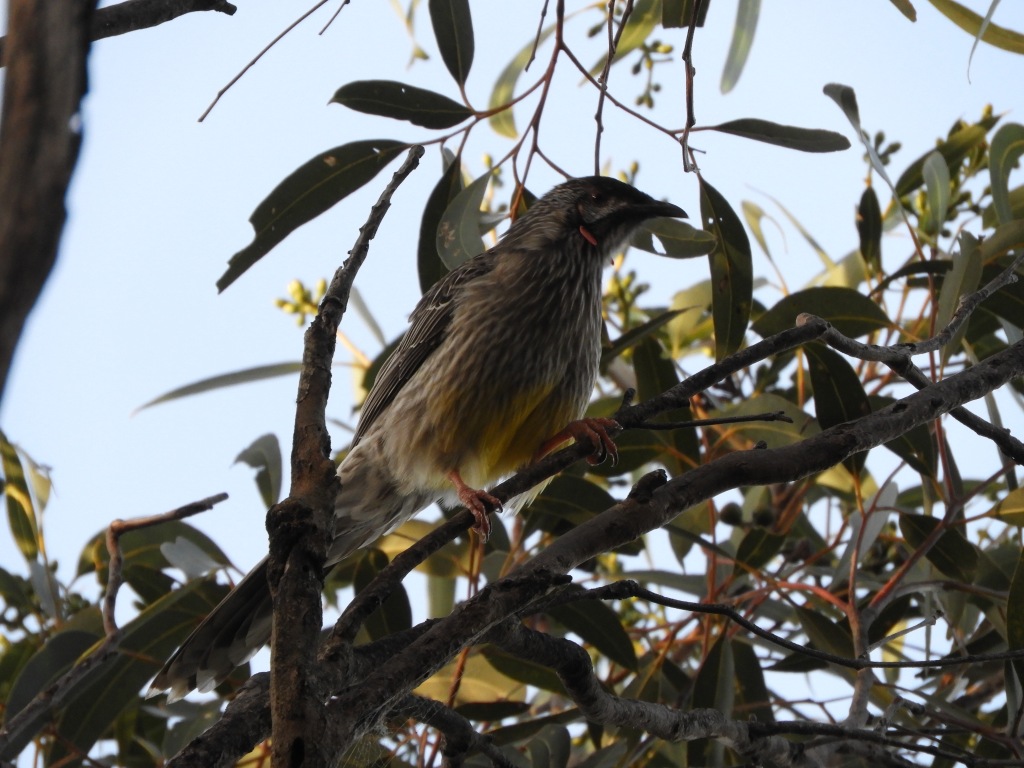
The feathers on its back are quite decorative, and a sun ray lights up the yellow on the bird’s belly:
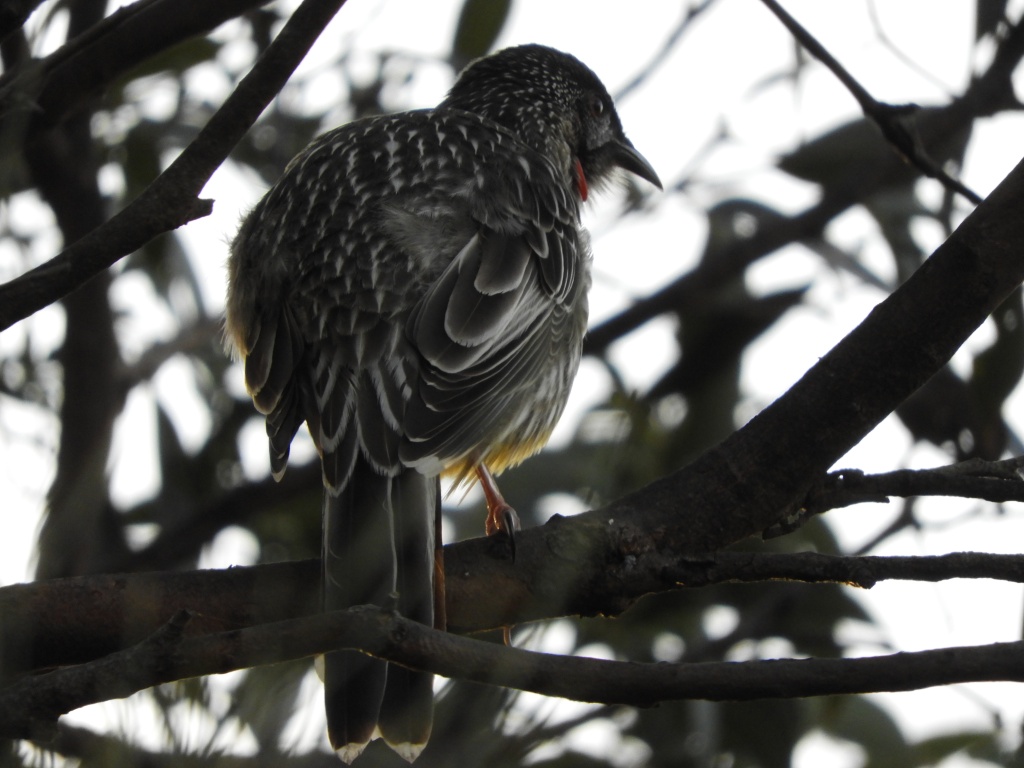
Common name: Red Wattlebird
Scientific name: Anthochaera carunculata
Approximate length: 35 cm
Date spotted: 24 April 2021 (autumn)
Location: Manly Dam Park, New South Wales, Australia: 33°46’10.0″S 151°14’53.6″E
Red Wattlebird on Banksia
Red Wattlebirds are large, noisy honeyeaters. They get their name from the red flaps of skin below their eyes. This one was feeding on the nectar of a Heath Banksia flower:
The next picture shows both wattles on the bird’s neck:
Common name: Red Wattlebird
Scientific name: Anthochaera carunculata
Approximate length: 35 cm
Date spotted: 18 July 2020 (winter)
Location: Manly Dam National Park, New South Wales, Australia. Approximate map reference: 33°46’27.0″S 151°14’57.6″E
Little Wattlebirds are common in the area too. The two birds can be hard to tell apart. Red Wattlebirds are larger (approx 35 cm from head to tail) whereas Little Wattlebirds measure approximately 30 cm. Little Wattlebirds don’t have the large red wattles. Here’s a Little Wattlebird that I photographed a while ago:
Red Wattlebird eating lerp
Red Wattlebirds are large honeyeaters, often seen diving through the foliage and chasing other birds away from a prized source of sugar. This one was making a lot of noise crashing through the branches. Probably on a sugar high. I think the white fuzzy stuff attached to its beak is lerp – crystalised honeydew exuded by bugs as a protective covering. A sweet treat for a bird. Red Wattlebirds get their name from the red wattles hanging below each cheek.
Common name: Red Wattlebird
Scientific name: Anthochaera carunculata
Approximate length: 35 cm
Date spotted: 11 November 2018 (Spring)
Location: Manly Dam National Park, New South Wales, Australia: 33°46’36.6″S 151°15’17.9″E
Red Wattlebird nest may be in peril
My previous post introduced the nest that a pair of Red Wattlebirds have built in a tree fern in my garden. Things are looking a little perilous for the nest. The tree fern has put in a growth spurt, its new fronds lifting parts of the nest into an untidy jumble.
This is what the nest looked like yesterday. Notice the new, brown fern fronds unfurling in the midst of the grey matter that forms the birds’ nest:
Compare that with the photo I took a week earlier, on 22 December, as shown in my previous post:
The parents still seem attentive. I’ve seen them flit in and out of the nest. Here’s one of them grabbing nourishment yesterday, from the nearby Banksia that seems to be their principle source of nourishment while nesting. The ghastly noise in the background is the cicados, who are out in full force this summer:
Birds are quite handy with their beaks and feet. I hope they manage to push the nest and eggs into a safe place as the fern tree grows.
Common name: Red Wattlebird
Scientific name: Anthochaera carunculata
Approximate length: 35 cm
Date spotted: 29 December 2017 (Summer)
Location: Allambie Heights, near Sydney, Australia
Red Wattlebird nesting in a tree fern
Red Wattlebirds are the second largest honeyeaters in Australia. They’re noisy, aggressive, and sleekly pretty. And now we have a couple nesting in our garden.
I’d noticed recently that a Red Wattlebird was more aggressive than usual. It started swooping at me when I was hanging up washing. At the best of times, hanging the washing is a precarious activity in my backyard. It involves a bit of rock climbing and a skilled balancing act. Add a fierce bird, and things get interesting.
A few days later, I noticed the bird land on a high branch, take a careful look around while trying to appear nonchalant, then duck quickly into the top cover of a tree fern. Interesting. So I got out my zoom lens to take a look.
The nest is in the right-most tree fern in this photo. I’ve put up my washing line on the left, for local colour:
(In case you’re wondering: the house up above belongs to the neighbours. Mine is below, not in the picture)
A closer view of the tree fern:
Even closer, you can see the nest with a bird’s tail pointing out to the right:
Occasionally the parents leave the nest unattended. I haven’t spotted any movement, so I think the eggs haven’t hatched yet:
The birds have picked up some of the Spanish Moss from our garden, and used it to decorate the nest. This is our supply, handily positioned just a few metres from the tree fern:
Sitting on a nest is demanding work. One of the parents emerged for a good stretch:
And a bit of grooming:
Then dived down to sip some nectar from a Banksia tree, which we’ve also positioned just a handy few metres from the fern tree. In this picture you can see the two red wattles below the beak that give the bird its name:
Here’s a picture of one of the local Red Wattlebirds on a nearby tree a few days earlier. It’s likely to be one of the nesting birds, though I don’t know for sure:
Common name: Red Wattlebird
Scientific name: Anthochaera carunculata
Approximate length: 35 cm
Date spotted: 22 December 2017 (Summer)
Location: Allambie Heights, near Sydney, Australia

